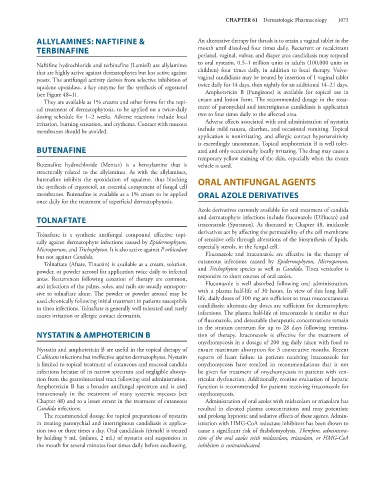Page 1087 - Basic _ Clinical Pharmacology ( PDFDrive )
P. 1087
CHAPTER 61 Dermatologic Pharmacology 1073
ALLYLAMINES: NAFTIFINE & An alternative therapy for thrush is to retain a vaginal tablet in the
TERBINAFINE mouth until dissolved four times daily. Recurrent or recalcitrant
perianal, vaginal, vulvar, and diaper area candidiasis may respond
Naftifine hydrochloride and terbinafine (Lamisil) are allylamines to oral nystatin, 0.5–1 million units in adults (100,000 units in
that are highly active against dermatophytes but less active against children) four times daily, in addition to local therapy. Vulvo-
yeasts. The antifungal activity derives from selective inhibition of vaginal candidiasis may be treated by insertion of 1 vaginal tablet
squalene epoxidase, a key enzyme for the synthesis of ergosterol twice daily for 14 days, then nightly for an additional 14–21 days.
(see Figure 48–1). Amphotericin B (Fungizone) is available for topical use in
They are available as 1% creams and other forms for the topi- cream and lotion form. The recommended dosage in the treat-
cal treatment of dermatophytosis, to be applied on a twice-daily ment of paronychial and intertriginous candidiasis is application
dosing schedule for 1–2 weeks. Adverse reactions include local two to four times daily to the affected area.
irritation, burning sensation, and erythema. Contact with mucous Adverse effects associated with oral administration of nystatin
membranes should be avoided. include mild nausea, diarrhea, and occasional vomiting. Topical
application is nonirritating, and allergic contact hypersensitivity
is exceedingly uncommon. Topical amphotericin B is well toler-
BUTENAFINE ated and only occasionally locally irritating. The drug may cause a
temporary yellow staining of the skin, especially when the cream
Butenafine hydrochloride (Mentax) is a benzylamine that is vehicle is used.
structurally related to the allylamines. As with the allylamines,
butenafine inhibits the epoxidation of squalene, thus blocking ORAL ANTIFUNGAL AGENTS
the synthesis of ergosterol, an essential component of fungal cell
membranes. Butenafine is available as a 1% cream to be applied ORAL AZOLE DERIVATIVES
once daily for the treatment of superficial dermatophytosis.
Azole derivatives currently available for oral treatment of candida
TOLNAFTATE and dermatophyte infections include fluconazole (Diflucan) and
itraconazole (Sporanox). As discussed in Chapter 48, imidazole
derivatives act by affecting the permeability of the cell membrane
Tolnaftate is a synthetic antifungal compound effective topi-
cally against dermatophyte infections caused by Epidermophyton, of sensitive cells through alterations of the biosynthesis of lipids,
Microsporum, and Trichophyton. It is also active against P orbiculare especially sterols, in the fungal cell.
but not against Candida. Fluconazole and itraconazole are effective in the therapy of
Tolnaftate (Aftate, Tinactin) is available as a cream, solution, cutaneous infections caused by Epidermophyton, Microsporum,
powder, or powder aerosol for application twice daily to infected and Trichophyton species as well as Candida. Tinea versicolor is
areas. Recurrences following cessation of therapy are common, responsive to short courses of oral azoles.
and infections of the palms, soles, and nails are usually unrespon- Fluconazole is well absorbed following oral administration,
sive to tolnaftate alone. The powder or powder aerosol may be with a plasma half-life of 30 hours. In view of this long half-
used chronically following initial treatment in patients susceptible life, daily doses of 100 mg are sufficient to treat mucocutaneous
to tinea infections. Tolnaftate is generally well tolerated and rarely candidiasis; alternate-day doses are sufficient for dermatophyte
causes irritation or allergic contact dermatitis. infections. The plasma half-life of itraconazole is similar to that
of fluconazole, and detectable therapeutic concentrations remain
in the stratum corneum for up to 28 days following termina-
NYSTATIN & AMPHOTERICIN B tion of therapy. Itraconazole is effective for the treatment of
onychomycosis in a dosage of 200 mg daily taken with food to
Nystatin and amphotericin B are useful in the topical therapy of ensure maximum absorption for 3 consecutive months. Recent
C albicans infections but ineffective against dermatophytes. Nystatin reports of heart failure in patients receiving itraconazole for
is limited to topical treatment of cutaneous and mucosal candida onychomycosis have resulted in recommendations that it not
infections because of its narrow spectrum and negligible absorp- be given for treatment of onychomycosis in patients with ven-
tion from the gastrointestinal tract following oral administration. tricular dysfunction. Additionally, routine evaluation of hepatic
Amphotericin B has a broader antifungal spectrum and is used function is recommended for patients receiving itraconazole for
intravenously in the treatment of many systemic mycoses (see onychomycosis.
Chapter 48) and to a lesser extent in the treatment of cutaneous Administration of oral azoles with midazolam or triazolam has
Candida infections. resulted in elevated plasma concentrations and may potentiate
The recommended dosage for topical preparations of nystatin and prolong hypnotic and sedative effects of these agents. Admin-
in treating paronychial and intertriginous candidiasis is applica- istration with HMG-CoA reductase inhibitors has been shown to
tion two or three times a day. Oral candidiasis (thrush) is treated cause a significant risk of rhabdomyolysis. Therefore, administra-
by holding 5 mL (infants, 2 mL) of nystatin oral suspension in tion of the oral azoles with midazolam, triazolam, or HMG-CoA
the mouth for several minutes four times daily before swallowing. inhibitors is contraindicated.

